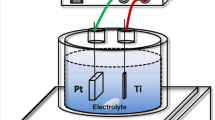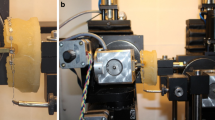Abstract
Background: The vast range of orthodontic wires made of different alloys makes it increasingly difficult for orthodontists to judge them. Coated orthodontic wires form a group of innovative guiding archwires.
Material and Methods: In the present in vitro study the frictional behavior of eight coated wires of different dimensions was investigated in archwire-guided canine retraction in the upper jaw. For this purpose five superelastic nickel titanium alloy wires (Titanol/reg; Low Force River Finish Gold and Gold 2: Forestadent®, Pforzheim Germany; Titanol® Superelastic tooth Sentalloy Ionguard™: GAC, Central Islip, NY, USA; NITI Imagination™: GAC, Central Islip, NY, USA), two β-titanium wires (TMA® Low Friction Ionguard: Ormco, Glendora, CA, USA; TMA® Low Friction Ionguard Purple: Ormco, Glendora, CA, USA) and one steel wire (Stainless steel Imagination™: GAC, Central Islip, NY, USA) were selected. The coatings were made of Teflon® or polyethylene, and by ion implantation. Three uncoated archwires (Rematitan® Lite Dimple; Dentaurum, Pforzheim, German; Titanol® Low Force River Finish: Forestadent®, Pforzheim, Germany; BioForce Sentalloy™: GAC, Central Islip, NY, USA) were used for comparison purposes. The force losses due to friction were measured using the Orthodontic Measurement and Simulation System (OMSS).
Results: The results indicated that all coatings can reduce frictional losses compared with an uncoated reference wire by the same manufacturer. Measured frictional losses ranged from 48.3–6.1% with the Teflon® coatings reducing the frictional losses to less than 10% in some cases.
Conclusion: An unequivocal correlation between the surface roughness and frictional forces of the wires could not be verified by scanning electron microscopy.
Zusammenfassung
Hintergrund: Die Vielzahl an orthodontischen Drähten aus diversen Legierungen macht es die Kieferorthopäden immer schwerer, sie zu beurteilen. Eine Gruppe von neu angebotenen Führungsbögen stellen die beschichteten orthodontischen Drähte dar.
Material und Methode: In der vorliegenden In-vitro-Studie wurde das Reibungsverhalten von acht beschichteten Drähten unterschiedlicher Dimension bei den bogengeführten Eckzahnretraktion im Oberkiefer untersucht. Neben fünf Nickel-Titan-Drähten (Titanol® Low Force River Finish Gold und Gold 2: Fa. Forestadent®; Titanol® Superelastic zahnfarben: Fa. Forestadent®; BioForce Sentalloy Ionguard™: Fa. GAC; NiTi Imagination™: Fa. GAC) wurden zwei β-Titan- (TMA Low Friction Iongard: Fa. Ormco; TMA Low Friction Ionguard Purple: Fa. Ormco) und ein Stahldraht (Stainless Steel Imagination™: Fa. GAC) ausgewählt. Die Beschichtungen bestanden aus Teflon®, Polyethylen oder Ionenimplantation. Als Referenz wurden drei unbeschichtete Drähte (Rematitan® Lite Dimple: Fa. Dentaurum; Titanol® Low Force River Finish: Fa. Forestadent®; BioForce Sentalloy™: Fa. GAC) in die Untersuchung einbezogen. Die Reibungsverluste wurden mit dem Orthodontischen Mess- und Simulations-System (OMSS) bestimmt.
Ergebnisse: Die Ergebnisse zeigten, dass alle Beschichtungen, verglichen mit einem unbeschichteten Referenzdraht desselben Herstellers, eine Reduktion der Reibungsverluste bewirken. Die gemessenen Reibungsverluste lagen zwischen 48,3% und 6,1%, wobei bei Teflon®-Beschichtungen der Reibungsverlust zum Teil auf unter 10% sank.
Schlussfolgerung: Ein eindeutiger Zusammenhang zwischen der Oberflächenrauheit und den Friktionswerten der Drähte konnte anhand von rasterelektronenmikroskopischen Aufnahmen nicht bestätigt werden.
Similar content being viewed by others
Author information
Authors and Affiliations
Additional information
Received: January 31, 2000; accepted: November 16, 2001
Rights and permissions
About this article
Cite this article
Husmann, P., Bourauel, C., Wessinger, M. et al. The Frictional Behavior of Coated Guiding Archwires. Journal of Orofacial Orthopedics / Fortschritte der Kieferorthopädie 63, 199–211 (2002). https://doi.org/10.1007/s00056-002-0009-5
Published:
Issue Date:
DOI: https://doi.org/10.1007/s00056-002-0009-5




